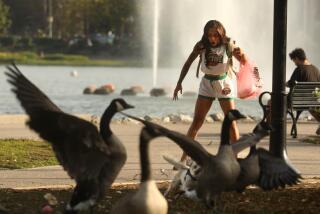Good for the Goose
- Share via
Canada geese grazing in grassy fields are one sign of winter in the San Fernando Valley.
Migrating geese fly from northern breeding grounds in late autumn and take up residence at the Sepulveda Basin, Pierce College and the Chatsworth and Encino reservoirs. Then in the spring, they return north.
Canada geese make their way here via the Pacific Flyway, a migration corridor 30 to 50 miles wide that takes the birds over river valleys and coastal wetlands.
As many as 3,500 geese have spent winter in the Valley. As development has swallowed fields and waterways, however, the number of geese counted in the Valley has dropped. In 1992, the number was 1,700, according to the San Fernando Valley Audubon Society.
Last year, bird counters tallied only 750.
While the number of Canada geese is dwindling in the area, tens of thousands of geese have overrun parks and ponds in the Pacific Northwest, the Midwest and New England, say wildlife observers.
Many of those birds no longer migrate because residents there have been feeding them long enough to disrupt their established routines.
White cheeks and a “chin strap” distinguish the Canada goose from other geese. An average bird weighs 8 to 10 pounds, is 35 to 37 inches long and has a 50-inch wingspan. The geese mate for life, which can exceed 30 years for those in captivity but is generally much shorter in the wild.
They eat small sprouting plants, grass, grain, corn and insects. And they are prey for coyotes, bobcats and wolves.
Both mother and father care for the young, which are hatched in the spring and late summer. After a high-protein diet of insects, they are strong enough by the fall to make the trip south with their parents.
Valley goose-watchers enthusiastically await the birds’ annual arrival. Since 1994, Pierce College has hosted a goose walk, offering a close-up view of Canada geese lolling on campus lawns and swimming in ponds.
More to Read
Sign up for The Wild
We’ll help you find the best places to hike, bike and run, as well as the perfect silent spots for meditation and yoga.
You may occasionally receive promotional content from the Los Angeles Times.






